AAO-NANOS Neuro-Ophthalmology Clinical Collection: Derived from the AAO-NANOS Clinical Neuro-Ophthalmology collection produced on CD. The images are of selected cases from the NANOS teaching slide exchange, and the CD was produced under the direction of Larry Frohman, MD and Andrew Lee, MD.
The American Academy of Ophthalmology (AAO); The North American Neuro-Ophthalmology Association (NANOS).
NOVEL: https://novel.utah.edu/
TO
| Title | Creator | Description | ||
|---|---|---|---|---|
| 26 |
 |
Motility Disturbances | Mitchell J. Wolin, MD | The trochlear nerve (fourth nerve) runs from the midbrain, exits dorsally, crosses in the anterior medullary velum, enters the subarachnoid space, travels within the lateral wall of the cavernous sinus, and enters the orbit through the superior orbital fissure. A trochlear nerve palsy may be due to ... |
| 27 |
 |
Motility Disturbances | Mitchell J. Wolin, MD | The trochlear nerve (fourth nerve) runs from the midbrain, exits dorsally, crosses in the anterior medullary velum, enters the subarachnoid space, travels within the lateral wall of the cavernous sinus, and enters the orbit through the superior orbital fissure. A trochlear nerve palsy may be due to ... |
| 28 |
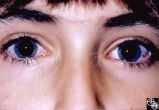 |
Ocular Manifestations of Congenital/Inherited Diseases | Larry P. Frohman, MD | This girl was 8 years old when these photographs were taken. She had been referred by pediatric neurology with ataxia. When seen, the findings of ataxia, poor convergence, early head thrusting maneuvers, and relatively preserved motility, in conjunction with the conjunctival findings as seen in the ... |
| 29 |
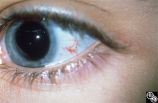 |
Ocular Manifestations of Congenital/Inherited Diseases | Larry P. Frohman, MD | This girl was 8 years old when these photographs were taken. She had been referred by pediatric neurology with ataxia. When seen, the findings of ataxia, poor convergence, early head thrusting maneuvers, and relatively preserved motility, in conjunction with the conjunctival findings as seen in the ... |
| 30 |
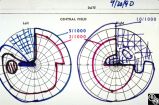 |
Chiasmal Syndromes | Larry P. Frohman, MD | This woman was 61 years old when she underwent initial neuro-ophthalmologic evaluation. Twenty-three years earlier, she had undergone removal of a pituitary adenoma followed by radiation therapy. At that time, she had noted a preoperative visual field defect that improved somewhat after the surgery.... |
| 31 |
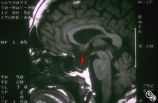 |
Chiasmal Syndromes | Larry P. Frohman, MD | This woman was 61 years old when she underwent initial neuro-ophthalmologic evaluation. Twenty-three years earlier, she had undergone removal of a pituitary adenoma followed by radiation therapy. At that time, she had noted a preoperative visual field defect that improved somewhat after the surgery.... |
| 32 |
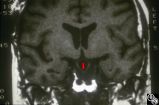 |
Chiasmal Syndromes | Larry P. Frohman, MD | This woman was 61 years old when she underwent initial neuro-ophthalmologic evaluation. Twenty-three years earlier, she had undergone removal of a pituitary adenoma followed by radiation therapy. At that time, she had noted a preoperative visual field defect that improved somewhat after the surgery.... |
| 33 |
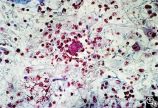 |
Chiasmal Syndromes | Larry P. Frohman, MD | This 39-year-old HIV-positive man presented in 1982 with 1 month of bilateral vision loss. His prior evaluation had included 2 CT scans, which suggested a fullness to the chiasm, and a spinal tap that showed 6 monocytes, 14 red cells, a protein of 81 mg/dl, and a glucose of 56 mg/dl, with a negative... |
| 34 |
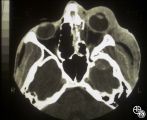 |
Neuro-Ophthalmic Imaging-CT Scan | Larry P. Frohman, MD | This patient was assaulted with a blunt object and suffered acute blindness due to traumatic optic neuropathy. Note how the lateral orbital wall has been fractured and displaced posteromedially into the region of the anterior optic canal. |
| 35 |
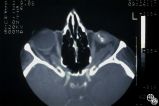 |
Ocular Manifestations of Congenital/Inherited Diseases | Larry P. Frohman, MD | On optic nerve CT scan, this patient with neurofibromatosis, type 1, shows the classic railroad-track sign of optic nerve meningioma and the kink sign of optic nerve glioma. Disease/Diagnosis: Neurofibromatosis, Type 1. |
| 36 |
 |
Motility Disturbances | Larry P. Frohman, MD | A 27-year-old healthy man presented for neuro-ophthalmologic evaluation for recurrent vertical binocular diplopia. In 1982, he had a minor blow to the head, and 12 days later he sustained vertical binocular diplopia, worse on downgaze, without ever having diurnal variation. His sense of taste was al... |
| 37 |
 |
Motility Disturbances | Larry P. Frohman, MD | A 27-year-old healthy man presented for neuro-ophthalmologic evaluation for recurrent vertical binocular diplopia. In 1982, he had a minor blow to the head, and 12 days later he sustained vertical binocular diplopia, worse on downgaze, without ever having diurnal variation. His sense of taste was al... |
| 38 |
 |
Motility Disturbances | Larry P. Frohman, MD | A 27-year-old healthy man presented for neuro-ophthalmologic evaluation for recurrent vertical binocular diplopia. In 1982, he had a minor blow to the head, and 12 days later he sustained vertical binocular diplopia, worse on downgaze, without ever having diurnal variation. His sense of taste was al... |
| 39 |
 |
Motility Disturbances | Larry P. Frohman, MD | A 27-year-old healthy man presented for neuro-ophthalmologic evaluation for recurrent vertical binocular diplopia. In 1982, he had a minor blow to the head, and 12 days later he sustained vertical binocular diplopia, worse on downgaze, without ever having diurnal variation. His sense of taste was al... |
| 40 |
 |
Systemic Disorders With Optic Nerve and Retinal Findings | Larry P. Frohman, MD | Cogan's syndrome is a vasculitic-autoimmune process with critical ocular features. In its original classical form it consists of nonluetic interstitial keratitis, with audiovestibular dysfunction, often with pain. More recently, it has been pointed out that there are nonclassical forms as well, part... |
| 41 |
 |
Neuro-Ophthalmic Vascular Disease | Mitchell J. Wolin, MD | Carotid cavernous fistulas (CCFs) are connections between the arterial blood flow from the carotid artery system and the cavernous sinus. CCFs may be direct high-flow fistulas or indirect low-flow fistulas. Most direct CCFs are due to trauma. Enlargement of the superior ophthalmic vein may be demons... |
| 42 |
 |
Systemic Disorders With Optic Nerve and Retinal Findings | Larry P. Frohman, MD | Skin rashes occur in about 30 percent of patients with sarcoid. When seen, the rashes offer an accessible site for obtaining histologic material for confirmation of the clinical diagnosis. Pair with 91_69. |
| 43 |
 |
Systemic Disorders With Optic Nerve and Retinal Findings | Larry P. Frohman, MD | Skin rashes occur in about 30 percent of patients with sarcoid. When seen, the rashes offer an accessible site for obtaining histologic material for confirmation of the clinical diagnosis. Pair with 91_68. |
| 44 |
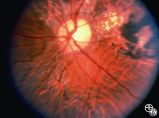 |
Ocular Manifestations of Congenital/Inherited Diseases | Steven Galetta, MD | This patient is a 40-year-old man with a history of abetalipoproteinemia (Bassen-Kornweig syndrome), diagnosed at age 9. Neurologic complications have included ataxia, retinal degeneration, peripheral neuropathy, progressive leg weakness, dysarthria, and intermittent bladder incontinence. On his neu... |
| 45 |
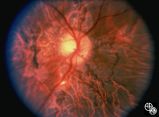 |
Ocular Manifestations of Congenital/Inherited Diseases | Steven Galetta, MD | This patient is a 40-year-old man with a history of abetalipoproteinemia (Bassen-Kornweig syndrome), diagnosed at age 9. Neurologic complications have included ataxia, retinal degeneration, peripheral neuropathy, progressive leg weakness, dysarthria, and intermittent bladder incontinence. On his neu... |
| 46 |
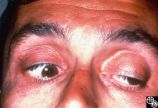 |
Ocular Manifestations of Congenital/Inherited Diseases | Steven Galetta, MD | This patient is a 40-year-old man with a history of abetalipoproteinemia (Bassen-Kornweig syndrome), diagnosed at age 9. Neurologic complications have included ataxia, retinal degeneration, peripheral neuropathy, progressive leg weakness, dysarthria, and intermittent bladder incontinence. On his neu... |
| 47 |
 |
Motility Disturbances | Larry P. Frohman, MD | A 27-year-old healthy man presented for neuro-ophthalmologic evaluation for recurrent vertical binocular diplopia. In 1982, he had a minor blow to the head, and 12 days later he sustained vertical binocular diplopia, worse on downgaze, without ever having diurnal variation. His sense of taste was al... |
| 48 |
 |
Motility Disturbances | Larry P. Frohman, MD | A 27-year-old healthy man presented for neuro-ophthalmologic evaluation for recurrent vertical binocular diplopia. In 1982, he had a minor blow to the head, and 12 days later he sustained vertical binocular diplopia, worse on downgaze, without ever having diurnal variation. His sense of taste was al... |
| 49 |
 |
Isolated Optic Neuritis/Neuropathy | Michael Wall, MD | This 36-year-old man noticed blurry vision in his right eye when attempting to sight a gun. He also reported bifrontal headaches responsive to aspirin. Acuity was 20/50 OD, 20/13 OS. His right eye could be refracted to 20/20 with a +2.50 sphere. A 0.3 right relative afferent pupillary defect was pre... |
| 50 |
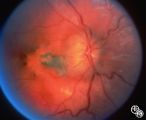 |
Isolated Congenital Optic Disc Anomalies | Joel M. Weinstein, MD | This 8-year-old boy presented with a 2-week history of decreased vision in the right eye. He had undergone a normal MRI and CSF examination, including intracranial pressure, before neuro-ophthalmologic assessment. The fundus photographs and fluorescein angiograms show subretinal neovascularization a... |
